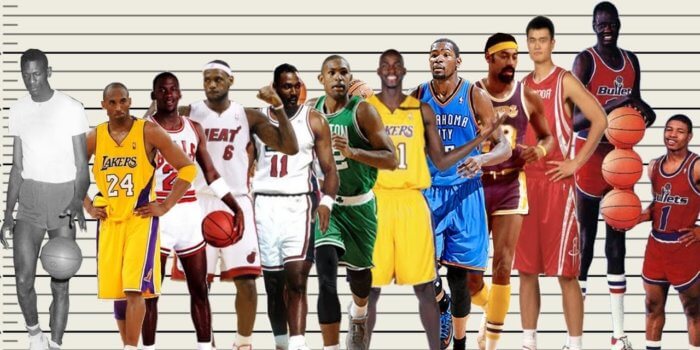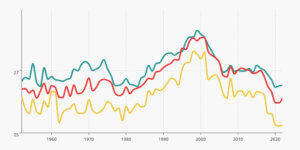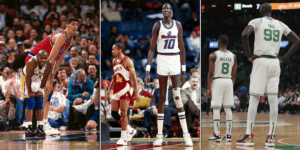This post was updated to include numbers from the 2021/2022 season
In a great piece for Sports Illustrated about 7-foot NBA players, author Pablo S. Torre estimates that the number of American men between the ages of 20 and 40 who are 7 feet or taller is likely below 70.
During the 2021-2022 NBA season, there were 13 American players who were at least 7 feet tall. So, if the estimates above are correct, that would mean that there is a whopping 18% chance that you are going to make it to the NBA if you are at least 7 feet tall!
Now maybe you don't need to grow to 7 feet to make it to the NBA, but there is no denying that body height is a huge advantage in basketball - you can only make up so much by learning how to jump higher. In this article, I want to take a closer look at the average height of NBA players across different positions and how it changed during the history of the NBA.
How tall is the average NBA player?
In the 2021-2022 NBA season, the average basketball player was 6'6" tall (198.6cm) which is about 8 inches taller than the average American male (5'9 1/2"), but still 13 inches smaller than the tallest player ever in the NBA, Georghe Muresan (7'7").
Interestingly, the average height of NBA players of previous seasons has been corrected downwards compared to my last study done in 2018. I attribute this to updated measurements of players' height.
Starting with the 2019-2020 season, NBA teams were forced to submit actual height numbers (without basketball shoes) measured by their team doctors. Before, numbers were often skewed by "politics". Kevin Durant liked to joke that he's 7-foot when talking to women, but 6-9 in basketball circles.
Average NBA player height by year
If we take a look at the average height of NBA players during the history of the league we can see that basketball players in 1952 were almost 3 inches smaller than today!
After that, players continuously grew taller until the apex was reached in 1987 at 6'7" tall (201.2cm). Since then we have seen a small decrease in player heights which might be attributed to the recent change in player measurement.
Interestingly, while average player height has stopped growing in 1987, players continued to get heavier until 2011 when they reached the peak of 221 lbs. This correlates with the NBA becoming more athletic, powerful, and muscular.
This trend has stopped during the last years as basketball is becoming become a much faster, and more perimeter-oriented game, so it makes sense that players are getting leaner again.
Evolution of Player Height & Weight in the NBA from 1952-2022
Average player height only tells half of the story. It doesn't give you insights into how height is distributed among the players. Is every player exactly 6'6", or are there a ton of guards around 6 feet and a lot of centers around 7 feet and it just happens to average out to 6'6?
If we take a look at the chart below we can, for example, observe that NBA players at 6'5" are most common and account for 13.7% of all minutes played.
Distribution of Height in the NBA in 2022
At the extremes, you will notice that there were only 21 players at 6 feet or below (2.5% of playing time) and 29 players at 7 feet or taller (4.6%)
Overall, we observe a big concentration of players between 6'4" and 6'8" - these players made up over half of all minutes played!
If we consider how common a body height of 6ft is among the general population and how few of them make it to the NBA, it becomes obvious just how skilled and insanely rare All-Stars like Chris Paul are!
How tall do you have to be play in the NBA?
Your dream is to make it to the NBA one day? Muggsy Bogues, the shortest NBA player ever, was only 5'3, but there is no doubt that it is easier to make the NBA if you are taller!
But just how tall do you need to be?
This calculator allows you to compare yourself to all NBA players who play at your position: Just pick your height, weight, and position and it will tell you how you stack up to NBA players! Just for fun, you can also compare yourself to players of other decades!
NBA Comparison Calculator
Average NBA point guard height
The average NBA point guard in 2022 is 6'2" tall.
We can see that point guards were smallest during the 1952/53 season with an average height of around 6 feet. Since then, they have grown taller almost every year until they reached a peak in 1987 at 6'3". During this time, big point guards like Magic Johnson at 6'9" or Reggie Theus at 6'7" were among the leaders in minutes played in the NBA.
Only 4 years later, in 1991, the average point guard had shrunk back to 6'1" with tiny players like Spudd Webb (5'6") and Muggsy Bogues (5'3") getting major minutes.
During the 2019/2020 season, point guards had a record height (6'2.5"). One reason for this is that basketball-reference.com categorized big and versatile players like Lebron James, Luka Doncic and Ben Simmons as point guards.
Overall, it feels like average player size at the point guard position is less determined by trends and more by player talent. If you have a legendary playmaker like Magic Johnson you make him your point guard, even if he has a power forward body. But no coach would put a regular power forward at point guard just to increase the size at this position. Basketball IQ and understanding of the game are much more important at this position!
During the 2021/2022 season, the most common height for point guards was 6'1", examples are players like Trae Young, Darius Garland, or Fred VanVleet. The biggest Point Guard was LaMelocBall at 6'17, the smallest was Facundo Campazzo at 5'10.
Average Height of Shooting Guards in the NBA
The average NBA shooting guard in 2022 is 6'5" tall.
In comparison to point guards, the change in height of shooting guards was more of a steady rise that has reached a plateau at 6'5" around the year 2000 and went down to almost 6'4" in recent years.
The most common heights for shooting guards are 6'4" and 6'5" which make up for almost 50% of played minutes at this position. Players with the most minutes at this size are Devin Booker, James Harden, and Zach LaVine.
NBA Height of Small Forwards
The average NBA small forward in 2022 is 6'6" tall.
Small forwards show a very similar trend as shooting guards, getting bigger continuously until hitting a plateau around 2000 just under 6'8 and losing an inch in recent seasons (again probably due to the more exact measurements).
Similar to the SG position, the SF position seems to be very well-defined with a majority of players measuring in either 6'5" or 6'7". Examples of SFs at this height are DeMar DeRozan, Joe Harris, and Jimmy Butler.
How tall are Power Forwards in the NBA?
The average NBA power forward in 2022 is 6'8" tall.
The power forward is probably the position that has changed the most in the modern NBA. PF's used to be big and strong low post players who battled for rebounds and scored on post-ups, but players like Dirk Nowitzki have completely changed the game. Nowadays, power forwards are often used to stretch the floor shooting a lot of threes and acting as playmakers on the perimeter.
Surprisingly, this change of playing style is not reflected at all in the average height of power forwards until the 2019/2020 were players were remeasured. Since 1987, they are on average 6'9" tall with very little year-to-year fluctuation until height starts dropping to 6'8".
How tall are Centers in the NBA?
The average NBA center in 2022 is 6'10" tall.
Centers show a very similar trend as Power Forwards. While average height reached a peak in 1996 with almost 7 feet, average weight continued to increase steadily until 2014 when it maxed out at 255lbs.
There is very little variety among centers when it comes to height: almost 60% of centers are either 6'10 or 6'11". Giants like Boban Marjanovic at 7'3" are very rare - even in the NBA!
Data Sources & Notes
Data was collected from basketballreference.com . There are a few shortcomings of this data:
- Players are assigned a single position per season. In reality, a lot of players play multiple positions every game. For example, some players start games as a shooting guard but take over point guard duties with a bench unit later.
- Height and weight data is registered once per player. This means that the data has Shaq weighing exactly 325lbs every season, and we all know that that's not true
- If you take a look at distributions over multiple seasons, players are counted once per season. This means, that if the graph says there were 3 players at 5'3 from 1992-1995, it refers to three seasons of Muggsy Bogues, not three different players
If you have any questions, please let me know in the comments!

Founder of thehoopsgeek.com. A passionate basketball enthusiast and coding geek, Andy combines a love for sports with technology.








How where you able to gather all of this data from basketballreference.com? I’m assuming you didn’t go through year by year and individually figure out what each players height, weight, position, etc. was by hand.
They have a csv export option. You will still need to do some work to clean up the data, but it’s pretty good!
What are the Standard deviations for height and weight?
I don’t have this available right now, but I’ll try to take a look at it when I find the time!
Yao’s undersized in the pic hehe as is Kobe perhaps. Durant is shorter than Garnett. LeBron is considerably heavier than the average SF eh? Heavier than the average centre even (Obviously he’s not still 250lbs after 20seasons!)
Thanks for the article, older era players aren’t as tiny as some lead us to believe. & is so misleading to see so many giants on tv and not realise how rare and uncommon it is for men to be that tall, even being 5’10” and above worldwide is a small minority (Read is 1/6). Media distorts our perception of reality! Humble 5’8″ here, just above world average but would make the top 10 shortest NBA players ever hehe.
I’m trying to find data on the average of every season since 1979, what’s the best way to do that?
You can find the raw data at http://basketballreference.com/
Why is Kevin Garnett in a Lakers jersey in the pic?
Good question 🙂
Pingback: The 4 Tallest NBA Players in History 2024: You Need to Know
Pingback: 10 Common Things that Are 19 Feet - MeasuringKnowHow
Pingback: Top 10 shooting guards with the most assists in NBA history - BallMuse
Pingback: Simplest Basketball Court Rules: Area Markings and Dimensions for Noobs